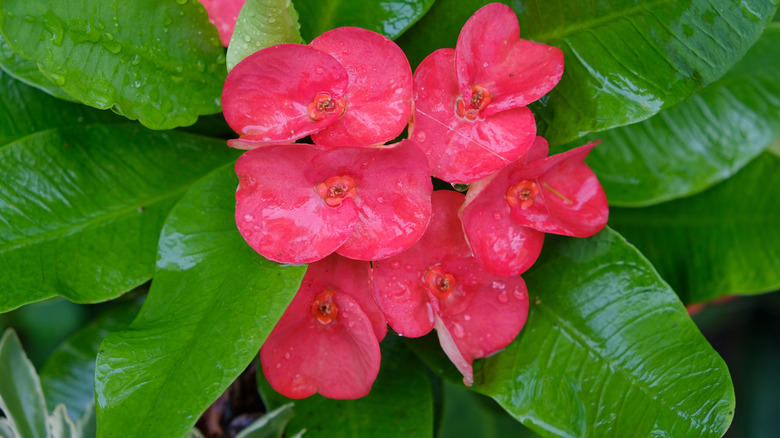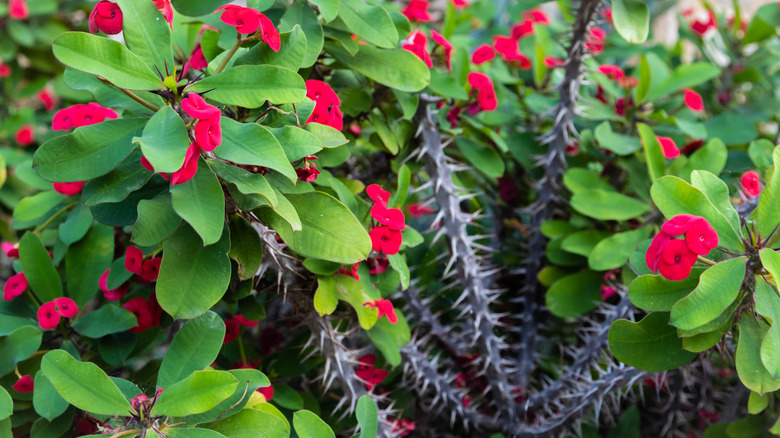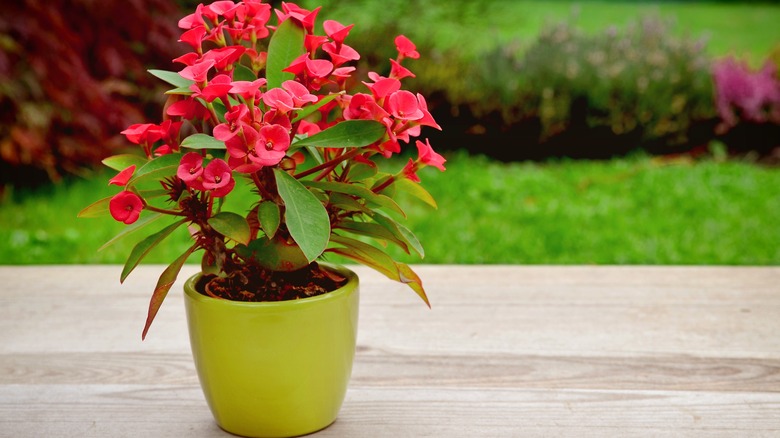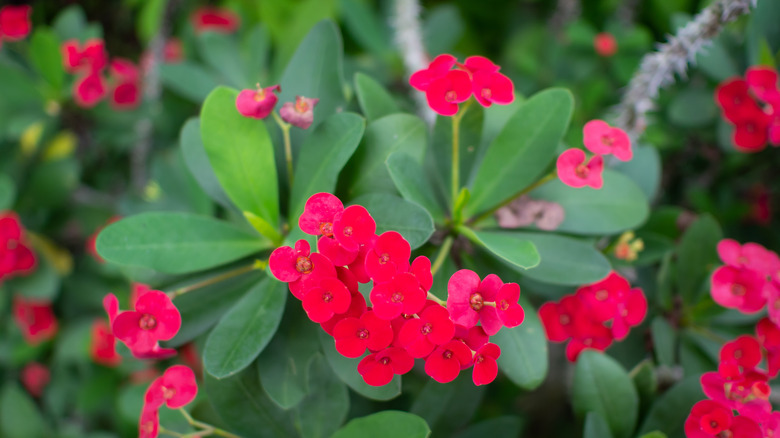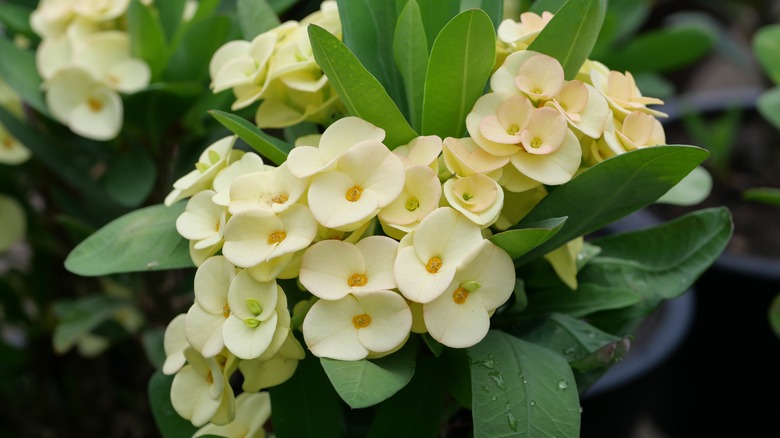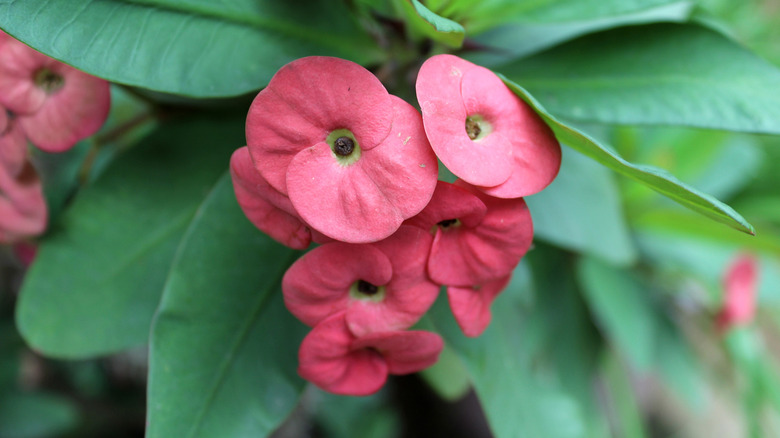How To Grow And Care For A Crown Of Thorns Plant
Euphorbia milii, or the crown of thorns plant, is a unique flowering succulent with an interesting history. Native to Madagascar and the Southeastern coast of Africa, this plant was thought to be introduced to the people of the Middle East during ancient times, Learn About Nature explains. Many believe that Jesus was forced to wear Euphorbia milii stems as a crown during his crucifixion, which gave this plant its common names: crown of thorns, Christ thorn, and Christ plant.
The crown of thorns plant features bright green leaves and thick woody stems covered in thorns. It blooms year-round with flowers surrounded by larger bracts that may be pink, white, yellow, orange, or red. The Christ thorn makes a beautiful houseplant as it doesn't require much humidity and enjoys temperatures of 65 to 75 degrees Fahrenheit, says Gardening Know How. Indoors it will only grow to about 2 feet high, while outdoors, it can reach up to 6 feet. Typically, its green leaves are only present on new growth, so a mature, outdoor crown of thorns plant can look quite different from one that is kept small indoors.
How to use a crown of thorns plant in garden
Crown of thorns plants are not often grown outdoors in the United States because they will only survive in USDA hardiness zones 9 to 11, as per The Spruce. So unless you live in warmer areas such as Florida, California, Arizona, Texas, or Hawaii, you'll need to keep your Christ plant indoors. If you want to grow a crown of thorns plant outside, give it plenty of room to grow and sunlight.
Also, when first transplanting it into your garden, you'll want to give it plenty of water until it is established, explains Gardening Know How. Afterward, you can cut back on watering as Euphorbia milii is a drought-tolerant succulent. Finally, you should find a sunny place for this plant to live in your garden: Lots of sun will allow more flowers to bloom, making it appear bright and healthy. Keep in mind, this plant can tolerate the shade if necessary, but putting it out of the sun will cause its leaves to wilt slightly and its flowers to disappear.
How to grow a crown of thorns plant
The most common way to grow crown of thorns plants is through propagation or buying a small plant from a local nursery. To thrive, it needs well-draining soil and compost for enrichment and coarse sand for additional draining. This plant's pot should not be much larger than its root ball. According to The Spruce, excess soil within a crown of thorns plant's container can lead to water retention, which can then make its roots rot.
When propagating Euphorbia milii, you'll also need gloves to protect yourself from its venomous sap. Begin by taking a tip cutting of at least 2 to 4 inches from the top of the plant; your cutting should include a new leaf bud for best results, as told by Plant Index. Next, wrap the stem in a paper towel to let it dry out and callus. After a few days, the cut end of your stem should appear puckered, which means it's ready to plant. Push your tip cutting into a small pot of well-draining soil and gently press the dirt around its base to secure it. While it is in its rooting phase, keep the soil damp and put it in a sunny window to help it grow.
How to care for a crown of thorns plant
Taking care of a crown of thorns plant is easy enough, especially when growing it indoors. The most important thing to give them is sunlight. The more sunlight they get each day, the more blooms they will have. Even three or four hours of sunlight per day can help them reliably flower, as per The Spruce. So, if you plan to keep your crown of thorns as an indoor plant, place it in a window facing south or west to give them access to the most direct sun.
To water your Christ thorn, it's best to check its soil by placing your finger into it: If the top inch of soil is dry, it's time to water. Do so generously until water runs out of the drainage hole into the saucer. In the winter, it will need slightly less frequent watering. At this time, only water if the top 2 to 3 inches of soil are dry. No matter the season, be sure to throw out any excess water left in the saucer to avoid root rot and other diseases. Crown of thorns plants can also benefit from fertilization with a balanced liquid plant fertilizer, as stated by Gardening Know How. Every other week during the plant's growing season in the spring, summer, and fall, you may feed it; however, you should be sure to dilute the solution first.
Crown of thorns plant varieties
If you've wanted to get your hands on a crown of thorns plant, there are plenty of varieties to choose from. Explained by Plant Index, hybridizers have managed to cultivate many versions of this plant, some smaller, brighter, and with larger flowers. Likely, your local nursery will carry a few variations of the Christ plant. Possibly, some of these beautiful choices:
- "Creme Supreme Crown of Thorns" is one of the easiest variations of the crown of thorns plant to care for. It has longer leaves compared to the common plant and creamy white bracts.
- "Short and Sweet Crown of Thorns" gets its name from its size. This dwarf variety grows no taller than 18 inches, and its bracts are a beautiful rosy red.
- "Brush Fire Crown of Thorns" is one of the most popular variations with bright red bracts and thick, waxy leaves.
- "Mini-Bell Crown of Thorns" is another dwarf variety characterized by smaller red bracts than the norm.
- "White Lightning Crown of Thorns" is a variegated type of the crown of thorns plant. It features light green leaves streaked with white and reddish-pink bracts.
Is the crown of thorns plant toxic?
The crown of thorns plant is, unfortunately, toxic. Euphorbia milii is harmful to humans and pets, causing diarrhea, vomiting, and skin irritations. According to Learn About Nature, this is due to their sap which contains 5-Deoxyingenol, a naturally occurring chemical that can cause a range of dangerous symptoms in pets such as dogs, cats, and horses if ingested.
Additionally, the plant's spikes can be dangerous on their own. Dogs may bite and chew the stem, causing punctures and tears in their mouth, leading to infections. Children may also unknowingly grab the spikes causing painful wounds. To avoid injury or sap irritation, always watch your pets and young children around these plants. When pruning, propagating, or repotting your crown of thorns plant, make sure to wear gloves to ensure you never sting yourself or get the sap on your skin. Accidentally, getting the venomous sap in your eyes can cause burning and require medical attention.
How to repot a crown of thorns plant
You should repot your Christ thorn about every two years, says Gardening Know How, and plan to do so in the early spring or late winter. As the soil in the original container ages, it loses the ability to drain properly, leading to root rot. The materials you'll need to repot your crown of thorns plant are a well-draining succulent and cactus soil mix, gloves, and a new pot that is only a couple of inches larger than the original one.
Begin the repotting process by gently removing your plant from its old container, careful not to damage the plant or harm yourself with its thorns. To make removal more manageable, you may loosen the soil's grip on the edge of the pot with a flat tool such as a butter knife. Once out of its pot, separate the old soil from the roots with your fingers or a gardening fork. Then, place it in its new container, packing the new soil firmly on top of its roots. Finally, water the crown of thorns plant generously before placing it back in a sunny spot.
